
MS Achille Lauro was a cruise ship based in Naples, Italy. It was built between 1939 and 1947 as the ocean liner Willem Ruys for Royal Rotterdam Lloyd. In 1965 Achille Lauro bought the ship, had it converted into a cruise ship, and renamed it after himself. In 1985 it was hijacked by members of the Palestine Liberation Front.

An ocean liner is a type of passenger ship primarily used for transportation across seas or oceans. Ocean liners may also carry cargo or mail, and may sometimes be used for other purposes. The Queen Mary 2 is the only ocean liner still in service to this day.
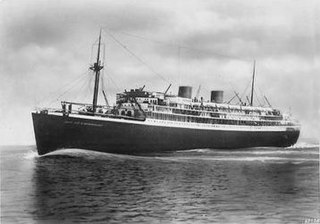
TSMS Lakonia was an ocean liner that was launched in 1929 for Netherland Line as the ocean liner Johan van Oldenbarnevelt. In 1962 she became the Greek Line cruise ship TSMS Lakonia. On 22 December 1963 she caught fire at sea and on 29 December she sank. 128 people were killed in the disaster.

Vasco da Gama is a cruise ship operated by German cruise line Nicko Cruises. Completed in 1993, she previously sailed for Holland America Line as MS Statendam, for P&O Cruises Australia as Pacific Eden and for Cruise & Maritime Voyages as Vasco da Gama. In 2020, following CMV's filing for administration, she was sold by CW Kellock & Co Ltd. at auction to Mystic Cruises' parent company, Mystic Invest for US$10,187,000.

MS Volendam is a Rotterdam-class (R-class) cruise ship belonging to Holland America Line. She was built in 1999 and sails out of Australia, Asia, and conducts cruises of the Inside Passage, traversing British Columbia and Alaska. She is the third ship in the fleet with that name, after SS Volendam (1922–1952) and SS Volendam (1972–1984).

MS Westerdam is a Vista-class cruise ship owned by Holland America Line. She is the third ship of the class to be operated by the line, as well as being the third ship to bear the name Westerdam. Her sister ships are Oosterdam, Zuiderdam, and Noordam. The beginning of the four ships' names represent the four directions of the compass in Dutch.

Stoomvaart Maatschappij Nederland or SMN, also known as the Netherland Line or Nederland Line, was a Dutch shipping line that operated from 1870 until 1970, when it merged with several other companies to form what would become Royal Nedlloyd.

MS Moby Otta is a cruiseferry, currently owned by the Italy-based shipping company Moby Lines and operated on their Genoa–Olbia service. She was built in 1976 by Flender Werke, Lübeck, West Germany as MS Tor Scandinavia for Tor Line. Between 1991 and 2006 she sailed as MS Princess of Scandinavia.

SS Leonardo da Vinci was an ocean liner built in 1960 by Ansaldo Shipyards, Italy for the Italian Line as a replacement for their SS Andrea Doria that had been lost in 1956. She was initially used in transatlantic service alongside SS Cristoforo Colombo, and primarily for cruising after the delivery of the new SS Michelangelo and SS Raffaello in 1965. In 1976 the Leonardo da Vinci became the last Italian Line passenger liner to be used in service across the North Atlantic. Between 1977 and 1978 she was used as a cruise ship by Italia Crociere but was laid up from 1978 onwards until 1982 when she was scrapped.

Flotta Lauro began as one of the largest Italian freighter fleets of the time founded by Gioacchino Lauro, and would eventually go on to operate passenger fleet from the end of WWII to the late 1980s.

Koninklijke Paketvaart-Maatschappij, was a Dutch shipping line in the Dutch East Indies, now Indonesia. It traded form 1888 to 1966. It was the dominant inter-island shipping line in the Dutch East Indies in the last half-century of the colonial era.
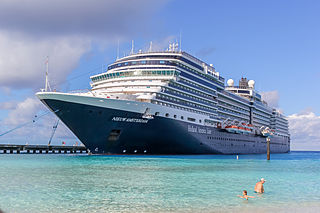
MS Nieuw Amsterdam is a Signature-class cruise ship sailing for Holland America Line. The 81st ship to enter Holland America's fleet, she is the fourth ship to bear the name Nieuw Amsterdam in the line's history.
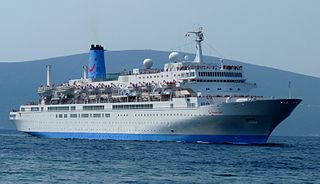
MS Marella Spirit was a cruise ship owned by Holland America Line and operated under charter by the United Kingdom-based Marella Cruises. She was built in 1983 at the Chantiers de l'Atlantique shipyard in France for Holland America Line as MS Nieuw Amsterdam. Between 2000 and 2001 she sailed for United States Lines, a subsidiary of American Classic Voyages, as MS Patriot. In 2002 she returned under Holland America Line ownership and reverted to the name Nieuw Amsterdam, but was not used in active service. During the same year she was chartered to Louis Cruise Lines, who in turn sub-chartered the ship to Thomson Cruises, with whom she entered service under MS Thomson Spirit in 2003.

SS Koning der Nederlanden was a Dutch ocean liner of the Netherland Line. She served from 1872 until her sinking in 1881 in the Indian Ocean while en route from Batavia to Amsterdam. Three of her lifeboats, with a total of 90 passengers and crew, were never found.

MS Koningsdam is a Pinnacle-class cruise ship operated by Holland America Line (HAL), a division of Carnival Corporation & plc. Koningsdam is the lead vessel of HAL's Pinnacle class, which includes Nieuw Statendam (2018) and Rotterdam (2021), all of which were built by Italian shipbuilder Fincantieri. Two years after the first steel was cut in February 2014 to commence construction, she was delivered to HAL in March 2016 and began operating the following month. At 99,863 GT, she became the largest ship ever commissioned for HAL upon her delivery.
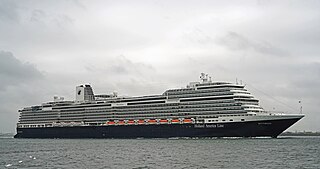
MS Rotterdam is a Pinnacle-class cruise ship operated by Holland America Line (HAL), a subsidiary of Carnival Corporation. Originally named Ryndam in development, she was renamed Rotterdam in July 2020 during construction to honor the name's legacy in the cruise line's history after six previous vessels in HAL's fleet bore the name. Rotterdam is the third of HAL's Pinnacle class in the fleet built by Italian shipbuilder Fincantieri and follows older sister ships Koningsdam (2016) and Nieuw Statendam (2018). Two years after the first steel was cut in March 2019 to commence construction, she was delivered in July 2021 and began operating in October 2021.
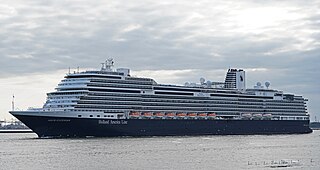
MS Nieuw Statendam is a Pinnacle-class cruise ship operated by Holland America Line (HAL), a division of Carnival Corporation & plc. Her name, Nieuw Statendam, alludes to the five previous ships in HAL's fleet named Statendam. She is the second of three Pinnacle-class ships built by Italian shipbuilder Fincantieri after Koningsdam (2016) and before Rotterdam (2021). Two years after the first steel was cut in July 2016 to commence construction, she was delivered to HAL in November 2018 and began operating the following month.

Royal Rotterdam Lloyd was a Dutch shipping line that was established in Rotterdam in 1883 as Rotterdamsche Lloyd (RL). It became "Royal Rotterdam Lloyd" in 1947. RL mainly operated scheduled passenger and mail services between Rotterdam and the Dutch East Indies. Its independent existence ended in 1970, when KRL merged with four other Dutch shipping companies to form the Nederlandsche Scheepvaart Unie (NSU). In 1977 NSU became Nedlloyd.
Cornelis Bijvoet (1890–1964) was a Dutch shipping engineer who served his country with distinction as a ship designer, a World War II naval officer and a senior technical advisor to the Dutch post-war shipping industry, overseeing the conversion of three troop ships to major immigrant ships.






















